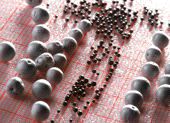Consumables
BASF opens new Neopor plant in Ludwigshafen

Friday 13. March 2009 - Capacity of the new plant: 90,000 metric tons per year; New production process: extrusion; Annual market growth of five percent worldwide for polystyrene foams in construction applications expected
Today, March 13, 2009, BASF is starting up a new plant for the insulation material Neopor in Ludwigshafen, Germany. Neopor is an expandable polystyrene (EPS). The plant has a yearly production capacity of 90,000 metric tons and works with a new process based on extrusion. The insulating capacity of Neopor is up to 20 percent better than that of Styropor (EPS), thus contributing to energy efficiency and the reduction of CO2 emissions.
“Neopor is a material that lowers energy consumption and costs during the construction and utilization of buildings, while improving the living comfort. Even though the global financial crisis has also had a negative impact on the construction sector, the worldwide demand for energy-efficient products will continue to grow, particularly for retrofitting thermal insulation in old buildings as well as for cooling buildings,” says Dr. Martin Brudermüller, responsible for plastics on BASFs Board of Executive Directors. “We expect the global market for EPS in the construction sector to grow by about 5 percent per year, a trend driven by energy prices that will rise over the long run and by statutory regulations.” In Germany, about 30 percent of all EPS-based insulating materials are currently used in new buildings, while 70 percent go into renovation projects. This is said to rise to 75 percent by 2012.
The gray Neopor is the refinement of the classic insulating material Styropor. It contains special graphite particles that reflect thermal radiation like a mirror, thus reducing heat losses in houses. BASF customers foam the Neopor granules and process them into insulating panels and molded parts that are then used to insulate exterior walls, roofs and floors. Insulating materials made of Neopor not only meet the standards for passive house construction but they also save at least 30 percent of the energy needed to cool residential buildings in warm climates.
In contrast to the suspension method employed so far, the extrusion process of the new plant will yield more uniformly sized granules and will permit a targeted setting of the panel properties, e.g. compression resistance. The new plant will ensure greater delivery reliability to BASF customers and give BASF greater flexibility to quickly respond to shifting market demands.
Insulating materials made of Neopor are instrumental in lowering the energy consumption of poorly insulated old buildings. For example: an old multi-family residential building uses 21 liters of heating oil per square meter per year for heating energy. If it is insulated so that it then needs only five liters, the residents of an 80-square meter apartment in this building will save some 1280 liters of heating oil per year and reduce CO2 emissions by about 4090 kilograms. The energy needed to produce Neopor for this insulation – about 1000 liters of heating oil per 80 square meter of living space – is already recouped after the first heating season.
